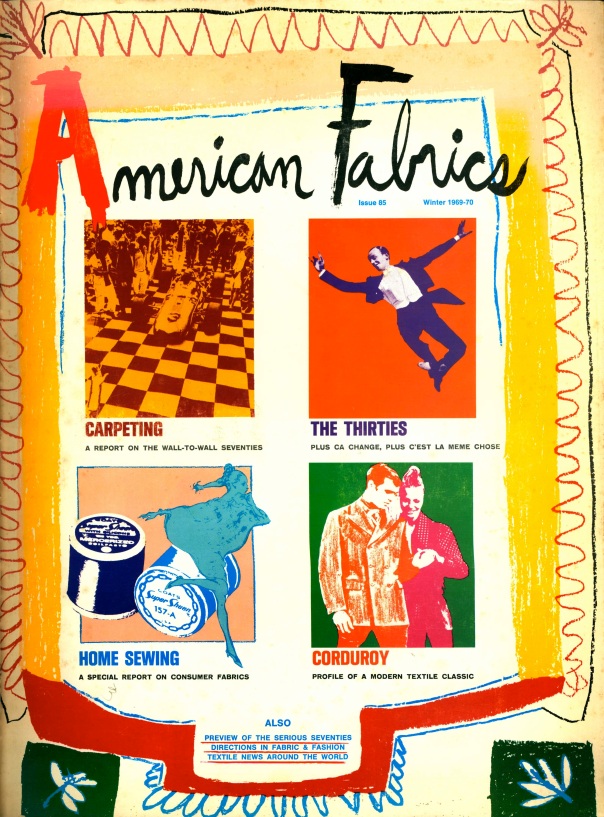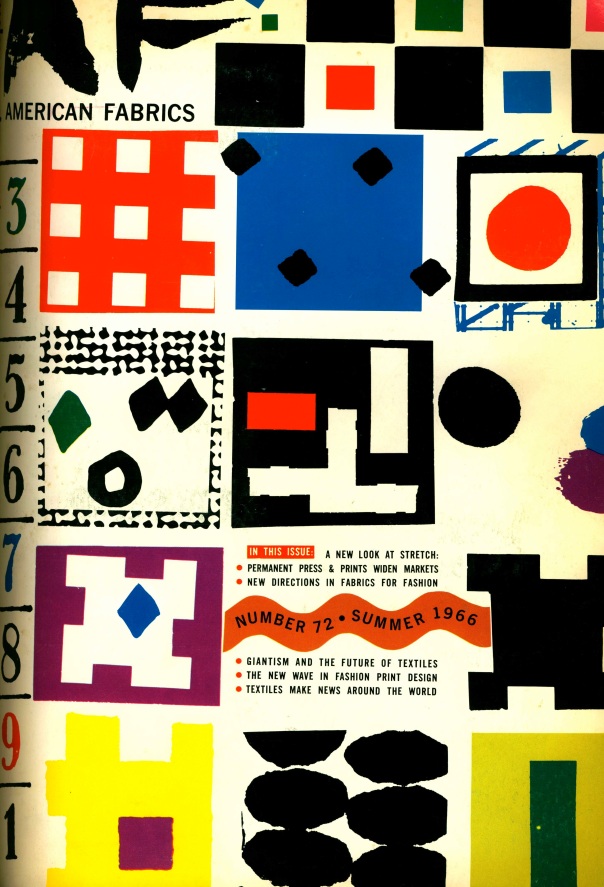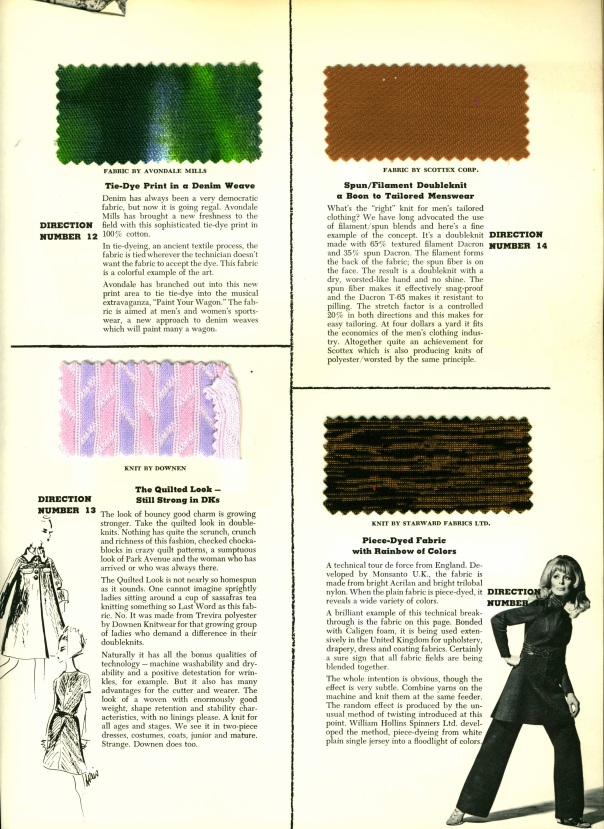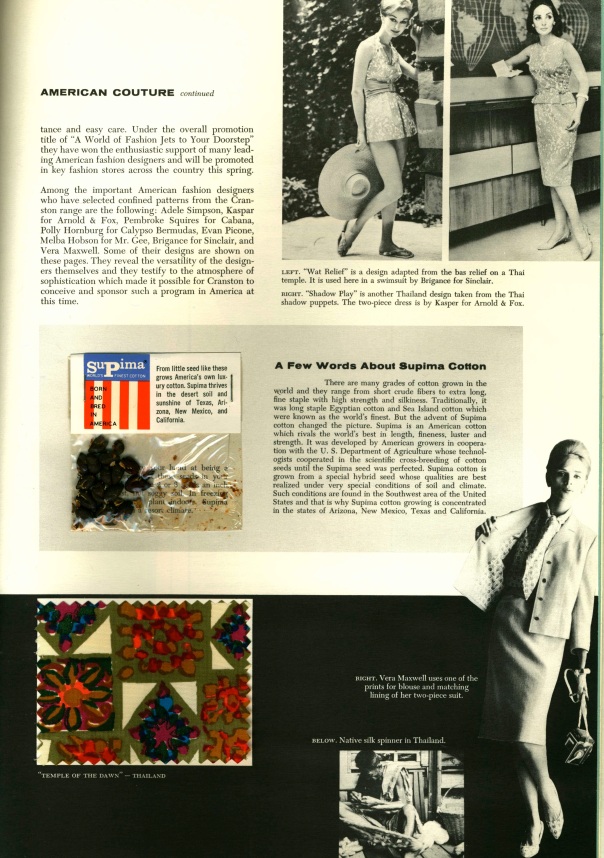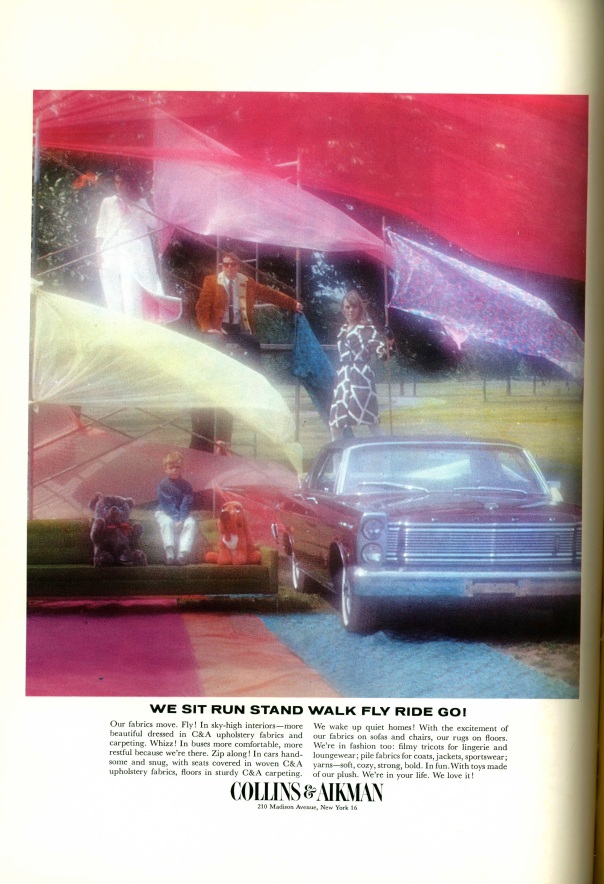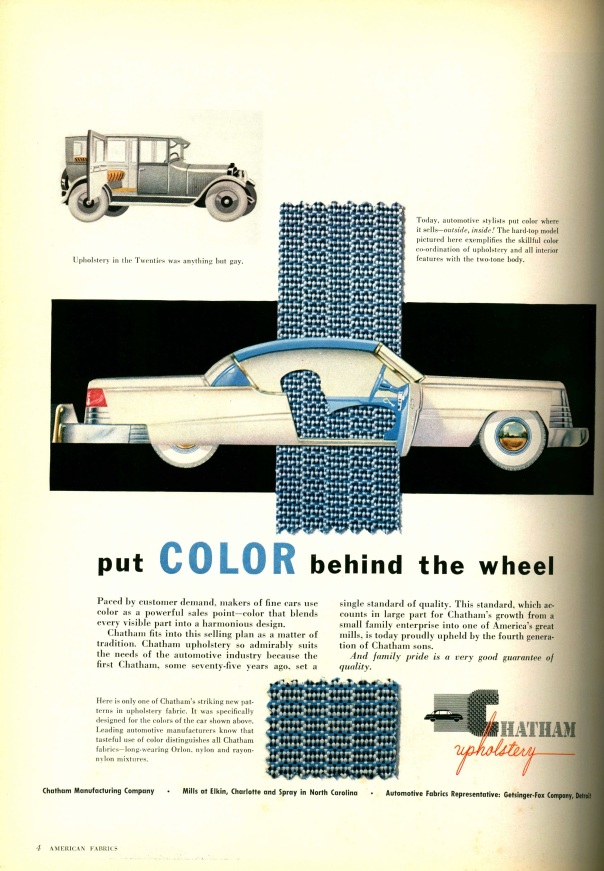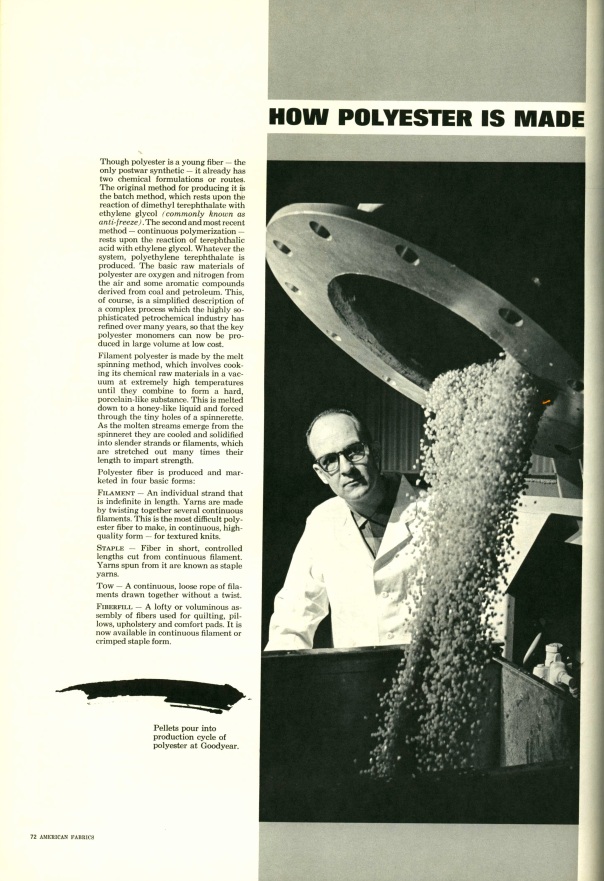Blog Archives
American Fabrics and Fashion
American Fabrics and Fashion (also called American Fabrics) was a commercial textile magazine created as a guide for manufacturers in the fabrics industry. In every issue there are dozens of physical fabric samples glued in, so in case you were wondering, “What did the 50’s feel like?”, here is the most literal answer to your question. Accompanying the samples are textile advertisements and sometimes the samples are even incorporated into the ads themselves. For anyone interested in fashion, textiles or all that is tactile, American Fabrics is a publication of great cultural and historical value.
We have 105 Issues of American Fabrics, 1946-1975.
African Arts
 From the UCLA African Arts homepage:
From the UCLA African Arts homepage:
“African Arts presents original research and critical discourse on traditional, contemporary, and popular African arts and expressive cultures. Since 1967, the journal has reflected the dynamism and diversity of several fields of humanistic study, publishing richly illustrated articles in full color, incorporating the most current theory, practice, and intercultural dialogue.”
Utilizing raw materials like straw and palm fronds, the artists represented here display an uninhibited mastery of caricature. They distort the literal human image with a sense of humor and playfulness into an iconic and sometimes frightening archetype.
Our current holdings of African Arts begin in 1976. Here are some selections from the earlier issues:

African Arts, Volume XI, Issue Number 02. January 1978.
“The Dan Masker zakpai ga from Gpapolulo. Its main function is to insure that women have put out their fires every noon during the dry season before the potentially dangerous afternoon winds begin to blow.”
Photo by Eberhard and Barbara Fischer.

 African Arts, Volume XI, Issue Number 02. January 1978.
African Arts, Volume XI, Issue Number 02. January 1978.
Traditional Ndebele Beadwork.
Top Left: “A woman wearing her mapoto stands before the brightly colored murals of her house.”
Top Right: “An elderly woman wearing a Linaga decorated with a broad strip of small white beads. It has designs in the traditional red-blue-green-orange color combination.”
Bottom Right: “A maiden poses with her mother’s magnificently beaded blanket. The predominance of blue, green and black beads indicates its recent vintage.”
Photos by Suzanne Priebatsch & Natalie Knight.

African Arts, Volume X, Issue Number 02. January 1977.
“Birthday for African Arts and the united States Bicentennial.” Tito Zungu, South Africa. Ballpoint pen and koki pen on paper. 20 cm x 25 cm.

African Arts, Volume X, Issue Number 02. January 1977.
Right: “Flower composition between door and window painted to represent formalized leaves. Xhosa, near Assegai Bush, Cape Province.”
Left: “Litema motif. Sotho, near Kroonstad, orange free state.”

African Arts, Volume XI, Issue Number 03. April 1978.
“The idean lyawo, described by some as reprseenting a bride or wife, who exudes quiet dignity and refinement in her dance and costume. Her body is enveloped in folds of costly fabric, and her elaborate hairstyle is bedecked with silver and gold. Iyawo’s facial features are rendered in appliqued red cloth bisected by shiny zippers.”
IIaro, Nigeria.
Photo: Henry John Drewal.

African Arts, Volume XI, Issue Number 03. April 1978.
Egungun (masked figures)
Ikenne, Nigeria.
Photos: Klindt Houlberg.

African Arts, Volume XX, Issue Number 01. October 1986.
Right: Masquerades at the Ebi-Woro Festival. Ijebu, 1982.
Photos: Henry John Drewal.
American Craft
 This bimonthly magazine—founded in 1941—was originally known as Craft Horizons but later changed to American Craft in 1979. It is dedicated to the advancement of the “age-old human impulse” to create things by hand. With an emphasis on nature and primitive art, Craft Horizons drew harsh contrast to the mass-produced products of its time.
This bimonthly magazine—founded in 1941—was originally known as Craft Horizons but later changed to American Craft in 1979. It is dedicated to the advancement of the “age-old human impulse” to create things by hand. With an emphasis on nature and primitive art, Craft Horizons drew harsh contrast to the mass-produced products of its time.
The magazine celebrates the use of unconventional materials, emerging and veteran artists, and helped define Craft as a concept, documenting the way it has evolved and sustained into the present day. Issues typically include insight on upcoming exhibitions, book reviews, events, and craft-related films as well as organizations and schools engaged in advancing the craft medium. It also gives novice writers and artists a place to showcase their work, as the magazine takes freelance writings and photography submissions for consideration towards each issue. Readers are also occasionally able to purchase affordable and innovative handmade goods featured in the magazine.
Funded by the nonprofit organization, The America Craft Council, American Craft is currently in its 72nd volume of publication and has over 14,000 issues (including the 38-year publication of Craft Horizons), making it one of the largest collections of art, craft, and design books in the country.
The Visual Arts Library is fortunate to own 46 of these volumes–dating back to 1962-and our current subscription ensures that our collection will grow with the publication.

American Craft, Volume 71, Issue Number 06. December/January 2012
Some artists view craft primarily as an activity, rather than an object. Left: Anne Wilson’s “Wind Up: Walking the Warp, Houston” (2010). Six dancers wound thread through the steel frame in this performance-turned-installation. Middle: Kelly Lamb (supported on her left by B Teamer Jeff Zimmerman) learns how to dance on molten glass as part of the performance art group’s 1997 “Tricks” video. Right: Mung Lar Lam hangs her geometric sculptures, made with cotton cloth, an iron, and starch, during an “Ironings” performance in 2010.

American Craft, Volume 71, Issue Number 06. December/January 2012
Randi Solin, a Washington D.C. born artist, studied at the New York State College of Ceramics. Solin creates abstract expressionist art she sees as “closer to paintings than fragile bud vases.”

Craft Horizons, Volume 22, Issue Number 05. September/October 1962
Left: Blue and white porcelain vase with relief decoration, 9 3/4″ high, from Bennington, Vermont, c. 1850. Right (top): Hard paste porcelain vase, 15″ high, embossed with gold and jewel work by Union Porcelain Works, Greenpoint, New York, c. 1884. [Left Page:] Right (bottom): porcelain pitcher, 8 1/4″ high, with relief decoration–Niagara Falls design–by United States Pottery Co., Bennington, Vermont, c. 1853-1858. [Right Page:] Left (top): painted vase, 8 3/4″ high, produced by Rockwood Pottery, Cincinnati, Ohio, and decorated by Artus Van Briggle, c. 1990. Left (bottom): blue “art nouveau” bowl, 5″ high, by Artus Van Briggle, Colorado Springs, Colorado, c. 1915. Right: hand-carved pale yellow “art nouveau” vase, 10 7/8″ high, by William Grueby, Boston, Massachusetts, c. 1910.

Craft Horizons, Volume 22, Issue Number 05. September/October 1962
Left: “Bottle Garden” by Sari Dienes of Stony Point, New York.

Craft Horizons, Volume 22, Issue Number 04. July/August 1962
Nicholas Vergette’s mixed media architectural murals. Left: Mosaic of ceramic and wood set in unglazed clay, 6′ x 4′. Center: Mosaic of blue, green, and orange shapes, 54′ x 26′. Right: Ceramic and wood mosaic, 6′ x 4′.

Craft Horizons, Volume 22, Issue Number 01. January/February 1962
Polish woodcarving, truly sculptural in its vigorously expressed from, captured the imagination of viewers in a comprehensive exhibition of Polish folk craft in every medium at the Brooklyn Museum, New York, November 28-January 14. In toys, kitchenware, animals, religious and secular figures, peasant carvers throughout the country practice an art that is at once traditional and contemporary. One of the most interesting centers of creative activity is the School of Kenar, located in the mountains of southern Poland, which gives training only in woodcarving and sculpture. There, craftsmen are producing work of such inventiveness and formal strength that it belongs with the sophisticated and informed sculpture of the international art community.

American Craft, Volume 72, Issue Number 01. February/March 2012
Top left: The crowd at the second Toledo Museum of Art glass workshop in June 1962. Front row, from left: Rosemary Gulassa, Harvey Leafgreen (a retired Swedish glass-blower recruited to help teach), June Wilson, Robert C. Florian, and Harvey K. Littleton. Back row, from left: John Karrasch, Octavio Medellin, Clayton Bailey, Stanley Zielinski, Norm Schulman, Diane Powell, Edith Franklin, and Erik Erikson. Bottom left: Fritz Dreisbach’s “Rich Golden Amber Mongo,” 1989 14 x 12 in. dia. Right: Harvey K. Littleton’s “Gold and Green Implied Movement,” 1987 31.25 x 19 x 14 in.

American Craft, Volume 72, Issue Number 02. April/May 2012
Kansas City Art Institute graduate and fiber artist, Yulie Urano’s knitted works serve as an exploration of her dual cultural identity. Urano uses her hands as knitting needles and knits her garments directly onto her body. Left: “Soft”, 2009, cotton. Top left: “Green”, 2010, cashmere. Middle left: “Orange”, 2010, cashmere. Right: “Grey”, 2010, silk.

American Craft, Volume 72, Issue Number 03. June/July 2012
From the humble wax crayon, Christian Faur creates sophisticated photo-realistic portraits.

American Craft, Volume 72, Issue Number 03. June/July 2012
Jiyoung Chung’s sculptural art re-envisions an ancient paper making technique. Left: Chung’s pieces are hung several inches away from the wall, creating dimension; the shadows they cast and subtle movements they make have a haunting effect. Middle left: “Whisper-Romance VI-II”, 2007, handmade paper, paper yarn, 2.8 x 2.1 feet. Right page: Right: “Whisper-Romance IV: Perspective”, 2007, handmade paper, paper yarn, 2 x 1.5 feet. Middle: “Whisper-Romance II-XXX”, 2007, handmade paper, paper yarn, 3.1 x 2 feet. Left: “Whisper-Romance: The Life”, 2009, handmade paper, paper yarn, 2.9 x 2 feet.

American Craft, Volume 73, Issue Number 02. April/May 2013
Michael Janis’s glass works, which employ the late-Renaissance technique of mirror anamorphosis, distorted images surround a silvered glass cylinder, in which the images may be seen in an undistorted form. Left: “The Optimism of Language”, 2012, fused glass, glass powder, silver, steel, 2 feet dia. x 7 feet. Right: “Lessons Learned and Unlearned”, 2012, fused glass, glass powder, silver, steel, 2 feet dia. x 7 feet.

American Craft, Volume 73, Issue Number 02. April/May 2013
In striking sculpture, Michael Peterson expresses the imagery and the energy of the natural world. Right: “Coastal Stack V”, 2008, madrone burl, 4 x 2.8 x 2.5 feet.

American Craft, Volume 71, Issue Number 06. December/January 2012
TV’s Nick Offerman stays grounded in craft.




